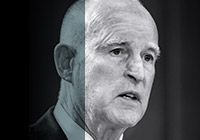WHEN PRESIDENT DONALD TRUMP pulled the United States out of the Paris climate agreement last year, scientists, politicians and environmentalists decried the move, calling it “shortsighted,” “disgraceful,” even “stupid and reckless.”
But for policymakers already pushing aggressive measures to control greenhouse gas emissions, Trump’s move was a reminder of their important mission. Within a week of the president’s announcement, California Gov. Jerry Brown was in China, meeting with President Xi Jinping and other world leaders in an effort to come up with a unified plan to curb climate change.
“Brown has made clear to the planet — to the global community — that California and other states and cities across the country are going to remain committed to the U.S. climate goals that are part of the Paris Agreement, and he’s played a really important leadership role in
showing just how powerful subnational jurisdictions can be,” said Ann Carlson, the Shirley Shapiro Professor of Environmental Law and co-director of UCLA’s Emmett Institute on Climate Change and the Environment.
Federal views on environmental policy shift from administration to administration, and divisions have tended to follow party lines. But the chasm between the Trump administration and supporters of strong regulation is more pronounced than with previous presidents. As a result, states, local governments and institutions are employing a variety of strategies to deal with policy differences, ranging from court challenges to setting their own environmental agendas on the national and international stage. That all but ensures conflict with the federal government and debate over primacy and the latitude of local government to defy or exceed Washington’s mandates.
“The Clinton administration talked a good game on climate change but didn’t do anything,” said Ted Parson, the Dan and Rae Emmett Professor of Environmental Law and co-director of UCLA’s Emmett Institute on Climate Change and the Environment. “The Bush administration talked a bad game but ended up doing little,” refusing to regulate greenhouse gas emissions and instead urging voluntary reductions among the private sector.
The Obama administration took climate change very seriously, Parson says. But rather than attempting to promote new legislation, given the Republican intransigence in Congress, it moved creatively to take action. Working within the context of existing law, the administration relied on a 2007 U.S. Supreme Court decision, Massachusetts v. EPA, which said greenhouse gas emissions are considered pollutants under the U.S. Clean Air Act and therefore could be regulated by the Environmental Protection Agency. Under the authority granted in the court ruling, the Obama administration enacted authorizations and requirements for motor vehicle emissions, power plant regulation, methane regulations for oil and
gas operations and other areas.
“Obama did as much as I can imagine anybody being Parson said. “So the Obama administration on this deserves enormous credit. They were dealt a rotten hand, and they got a lot out of it.”
Carlson says it is likely the Trump administration would have done nothing on climate change if it had started with a blank slate. “As it is, it’s trying to repeal most — although not all — of the policies that the Obama administration put into place. We don’t know entirely what they’re going to do across the board.”
Washington vs. Sacramento
What happens when state and federal governments are in opposition?
California stands in a unique position that allows it to avoid some of the harshest consequences of the Trump administration’s moves. Because California has the sixth largest economy in the world, it has been able to move forward on strong environmental policies that pave the way for other states — or even the federal government — to follow.
“We can, for example, issue our own auto standards because we have a big enough market that manufacturers are going to respond to us,” Carlson said. “They’re not going to walk away from the market.”
Through its strong cap-and-trade program, the state has demonstrated that revenue can be raised while acting responsibly with environmentally friendly policies, she says, noting that money received can be plowed back into programs that help reduce greenhouse gas emissions, such as subsidies for zero-emission or electric vehicles.
A special exemption to the 1970 Clean Air Act, called a “waiver from preemption,” has been key to California’s policymaking power. Because the state historically suffered serious problems with air pollution, in large part because of motor vehicle emissions, state lawmakers enacted tough air quality regulations in the 1950s — long before the federal government did so. The waiver, which remains in place today, allows the state to continue to pursue standards stronger than the federal government’s, with permission to do so from the EPA. Other states may follow California’s air standards as long as they do so exactly. Nearly one-third of the country has opted to do just that.
The waiver, Parson said, means “California has mostly been a leader on environmental policy for decades.”
The state benefits from climate policies that have remained relatively stable and comprehensive. That’s in large part because two consecutive governors — Brown and, before him, Arnold Schwarzenegger — made environmental issues a priority and pushed to share those policies and ideas with leaders in other states and cities around the world.
“Our last Republican governor, Arnold Schwarzenegger, was a very strong proponent of strong action on climate change — and it was popular for him,” Carlson said. “It was probably the thing he is best remembered for, his lasting legacy.”
Brown has embarked on a climate agenda with a goal of 1.5 million electric vehicles by 2025 and 5 million electric vehicles by 2030. He is calling for 50 percent of the state’s electricity to be generated by renewable sources by 2030. The state has enacted a strong cap and-trade
system and has pushed efficiency standards for buildings and appliances.
Local municipalities across the country are taking action as well. Los Angeles Mayor Eric Garcetti, for example, has pushed for the city to reduce greenhouse gas emissions by 45 percent by 2025, 60 percent by
2035 and 80 percent by 2050 against a 1990 baseline. In Santa Monica, the city is aiming to be one of the first carbon-neutral cities in the world by setting goals that include water self-sufficiency by 2020, zero waste by 2030 and, by 2050, an 80 percent reduction in emissions. On the East Coast, Connecticut, Delaware, Maine, Maryland, Massachusetts, New Hampshire, New York, Rhode Island and Vermont have formed the Regional Greenhouse Gas Initiative, or RGGI, to find ways to cap and reduce carbon dioxide emissions from the power sector.
States may enact strong measures, but they still need the blessing of the federal government. In a 2017 interview with Blueprint, California Attorney General Xavier Becerra emphasized that states should follow federal mandates. “We can do anything that we want so long as we’re respecting what the federal law says is applicable to the states on matters that the federal government has the right to weigh in on,” he said. “Typically, when we want to go in a slightly different direction, we need to seek clearance from the federal government.”
This means that much could change if the EPA follows through on threats to eliminate the emissions waiver. EPA administrator Scott Pruitt said he is re-evaluating the standards for cars and trucks in model years 2022 to
2025. Still unclear is what will happen in California.
“If you revoke the federal standards but you don’t revoke the California waiver, then California gets to go ahead and continue, and other states can opt in,” Carlson said. Without government regulation on the transportation side, Carlson says, emissions will go up.
In addition, Pruitt has set in motion a proposal to repeal the Clean Power Plan, which puts a cap on carbon emissions from power plants and promotes clean energy. The move to repeal the rule, a centerpiece of Obama’s climate plan, is currently open for public comment.
“The only question is how weak the next rule looks,” Carlson said.
Will Scott Pruit survive?
Parson says Pruitt has proposed or revised rules to weaken or overturn Obama administration regulations. In addition, he says, Pruitt has stopped enforcing existing laws, proposed budget cuts and has demoralized staff, leading to large numbers of departures or early retirements. “It appears that the EPA is one of the rare instances of competency in the Trump administration,” he said. “Scott Pruitt has proceeded almost entirely under the radar with a set of very damaging actions, only some of which are likely to be able to be overturned or reversed by the courts.”
The courtroom has long been a vehicle to bring about change; significant environmental regulations enacted in the United States are almost always litigated. During his tenure as Oklahoma attorney general, Pruitt filed 14 suits against the EPA. California and other states have sued to stop federal government measures or to force action by the federal government. Since Trump took office, California has taken action in the form of more than 45 lawsuits, amicus briefs, notices, motions and letters, according to data provided to Blueprint by the California Attorney General’s Office. The most recent suit, filed April 10, takes aim at the EPA’s repeal of a longstanding policy that requires major polluters, such as oil refineries and chemical plants, to take permanent action to reduce emissions.
“The Trump administration has been remarkably sloppy in the way that it has tried to roll back a number of rules, and the courts have put a stop to it,” Carlson said. “Over the long run, if they get their administrative procedures together, they can do a lot more harm.”
Congress so far has been unwilling to follow the deep cuts that the Trump administration wants, Carlson says, in part because environmental protection is popular across party lines. “If you clean up the Great Lakes or you make the air quality better in people’s neighborhoods, you can see that,” she said. “Climate change is harder because it’s harder to see.”
Regardless, the path to reducing greenhouse gas emissions will be challenging. “Nobody quite noticed all the measures to get us to 10 percent below 1990 [levels],” Parson says. “They’ll probably notice the ones that get us to 30 percent by 2030 because there will be more restrictions and there will be more effects on consumer prices.”
Brown has taken his climate change message beyond California, encouraging world leaders to take stronger action against rising temperatures. Last year, he and former New York mayor Michael Bloomberg led a U.S. delegation to the United Nations conference on climate change in Bonn, Germany. He also traveled to Brussels, Oslo and the Vatican. And he has scheduled an international gathering next fall in San Francisco to place California at the center of the global conversation.
“Brown has used his bully pulpit really effectively,” Carlson said. “He’s been visionary about seeing the way in which he can use his position as governor to really be a global leader on environmental issues. Trump has given him a big opening, and he’s taken advantage of that.”
The state is likely to remain on track after Brown leaves office in 2019, she says. “But boy would it be nice for the state to have its neighbors participating, and not be the only state that is that far out front.” The Clean Power Plan provided opportunities for other states to participate in and to work together on a national push to reduce emissions.
“If California shows that it works, then the rest of the country can come along,” Carlson said. “California can be a leader — and it’s been a leader, not just in reducing its emissions but in showing other jurisdictions how to do it and do it in a way that keeps the economy growing. This is a global problem. California can’t solve it by itself.”

























